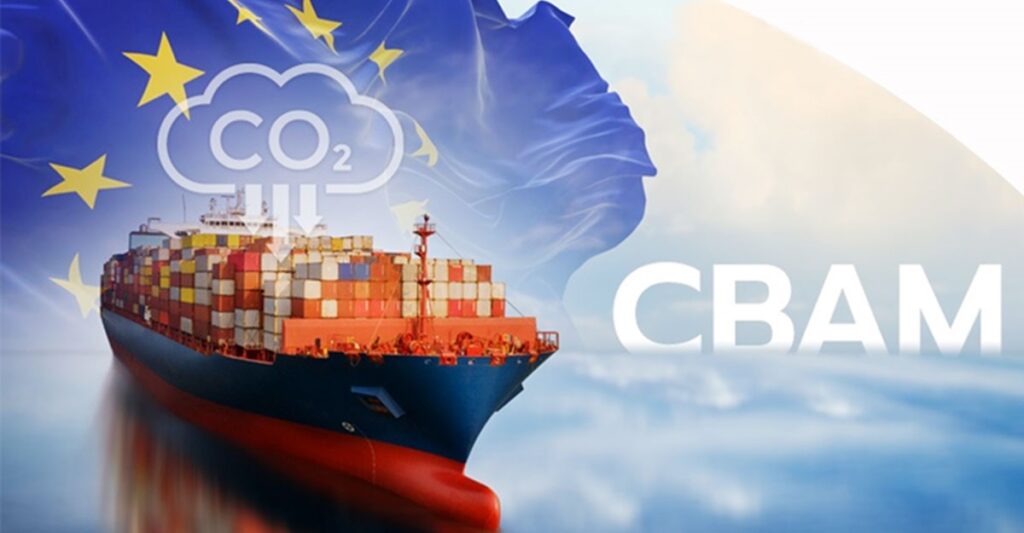Impact on the business of the EU Green Deal and ESG Policies
欧盟绿色协议及ESG政策对商业的影响
Introduction
To address climate change and advance the process of carbon neutrality, the European Union has introduced a comprehensive package of green policies in recent years, covering various aspects such as climate, energy, transportation, and taxation. In the newsletter, we will briefly review the recent policies and activities related to the EU, enabling enterprises to promptly and accurately grasp the latest strategic layout of the European Union in promoting sustainable development.
引言
为应对气候变化、推进碳中和进程,欧盟近年来推出了一系列全面的绿色政策,涵盖气候、能源、交通和税收等多个方面。在本期时事通讯中,我们将简要回顾欧盟近期相关政策与活动,助力企业及时、准确地把握欧盟推动可持续发展的最新战略布局。
Policies’ De-brief
- EU “2024 Climate Action Progress Report”
A. Major Emission Reduction Achievements
1. Remarkable Emission Reductions in the Energy Sector: The emissions of electricity and industrial facilities registered under the EU Emissions Trading System decreased by a record 16.5% in 2023. Under the EU Emissions Trading System, due to the growth of renewable energy sources, especially wind and solar energy, the emissions from electricity production and heating decreased by 24%.
2. Increase in Natural Carbon Absorption: In 2023, the EU’s natural carbon absorption increased by 8.5%, reversing the recent downward trend in the land use and forestry sectors.
B. Future Goals and Plans
1. Sustained Emission Reduction: Macfie, a spokesperson of the European Commission, said that if the current emission reduction momentum is maintained, the EU is expected to achieve the goal of reducing emissions by at least 55% by 2030. In the future, from now until 2030, the EU needs to achieve an average annual emission reduction of 134 million tons of carbon dioxide equivalent.
2. Improving Policies and Regulations: In the first half of 2024, the EU legislated to promote carbon capture and storage, the deployment of CO₂ transportation infrastructure, industrial carbon removal, and carbon resource recycling.
3. International Cooperation: The EU will continue to carry out international cooperation
政策解读
- 欧盟《2024年气候行动进展报告》
A.主要减排成果
1.能源领域显著减排:2023年,欧盟排放交易体系登记的电力和工业设施排放量创纪录地下降了16.5%。在欧盟排放交易体系下,由于可再生能源(尤其是风能和太阳能)的增长,电力生产和供暖产生的排放量下降了24%。
2.自然碳吸收增加:2023年,欧盟自然碳吸收量增长了8.5%,扭转了近期土地利用和林业部门的下降趋势。
B.未来目标与计划
1.持续减排:欧盟委员会发言人麦克菲表示,如果保持目前的减排势头,欧盟有望实现到2030年至少减排55%的目标。从现在到2030年,欧盟未来需要实现年均减排1.34亿吨二氧化碳当量。
2.完善政策法规:2024年上半年,欧盟通过立法推动碳捕获与封存、二氧化碳运输基础设施的部署、工业碳移除以及碳资源回收利用。
3.国际合作:欧盟将继续积极开展国际合作。
- EU “2024 Green Bond Allocation and Impact Report”
A. Bond Issuance
Since October 2021, the EU has issued over 65 billion euros of EU green bonds. The funds raised from these bonds are mainly used in areas such as clean energy, clean transportation, and energy efficiency, demonstrating the EU’s leading position in the field of sustainable finance. Currently, the unallocated proceeds of green bonds amount to 16.2 billion euros, which will continue to be invested in projects in Member States in the future.
B. Fund Allocation
Energy Efficiency Sector: It accounts for 42% of fund allocation. A large amount of funds are invested in projects to improve energy efficiency, such as energy saving renovations of existing buildings, including the installation of high – efficiency insulation materials, energy saving windows, as well as the promotion of energy saving industrial equipment and technologies, to reduce energy waste and consumption.
Clean Transportation and Infrastructure Sector: It accounts for 34% of fund allocation. The funds are mainly used to support the construction of electric vehicle charging infrastructure, the upgrading of public transportation, and the development of low – carbon transportation solution such as railways, to promote the green transformation of the transportation sector.
Clean Energy and Network Infrastructure: It accounts for 8.7%. The investment goes to renewable energy projects, such as the construction of largescale solar power plants, wind farms, as well as the development of smart grids and the research and development of energy storage technologies to ensure the stable supply and efficient transmission of clean energy.
C. Environmental Benefit Achievements
Significant Emission Reduction: Clean energy and network projects are expected to reduce emissions by 21.8 million tons of carbon dioxide equivalent per year, and clean transportation and infrastructure projects are expected to reduce emissions by 20.4 million tons of carbon dioxide equivalent per year. The entire measure is expected to reduce greenhouse gas emissions by approximately 55 million tons within the EU annually, exceeding the 44.2 million tons estimated last year.
Promote Sustainable Development: Through the rational allocation and effective utilization of green bond funds, while promoting the EU’s economic recovery from the COVID – 19 pandemic, it has accelerated the EU’s green and digital transformation, making an important contribution to achieving the EU’s climate goals and sustainable development goals.
- 欧盟《2024年绿色债券分配与影响报告》
A.债券发行情况
自2021年10月起,欧盟已发行超650亿欧元的欧盟绿色债券。这些债券筹集的资金主要用于清洁能源、清洁交通和能源效率等领域,彰显了欧盟在可持续金融领域的领先地位。目前,绿色债券未分配收益达162亿欧元,未来将继续投资于各成员国的项目。
B.资金分配情况
能源效率领域:占资金分配的42%。大量资金投入到提高能源效率的项目中,如对现有建筑进行节能改造,包括安装高效隔热材料、节能窗户,以及推广节能工业设备和技术,以减少能源浪费和消耗。
清洁交通与基础设施领域:占资金分配的34%。资金主要用于支持电动汽车充电基础设施建设、公共交通升级,以及铁路等低碳交通解决方案的开发,推动交通运输行业的绿色转型。
清洁能源与网络基础设施领域:占比8.7%。投资流向可再生能源项目,如大型太阳能发电厂、风力发电场的建设,以及智能电网的开发和储能技术的研发,以确保清洁能源的稳定供应和高效传输。
C.环境效益成果
显著减排:清洁能源与网络项目预计每年减少2180万吨二氧化碳当量的排放,清洁交通与基础设施项目预计每年减少2040万吨二氧化碳当量的排放。整套举措预计每年在欧盟境内减少约5500万吨温室气体排放,超过了去年预估的4420万吨。
促进可持续发展:通过绿色债券资金的合理分配与有效利用,在推动欧盟经济从新冠疫情中复苏的同时,加速了欧盟的绿色与数字化转型,为实现欧盟的气候目标和可持续发展目标做出了重要贡献。

A. Main Contents
1. Disclosure Principle: Enterprises are required to disclose information in accordance with the “double materiality” principle. That is, they should comprehensively and meticulously disclose how sustainable development issues affect their business operations (financial materiality), as well as the impact of their business activities on the environment and society (impact materiality).
2. Regulatory Mechanism: Enterprises should have their sustainability reports audited and verified by a third party. From 2026, limited assurance will be required, and from 2028, reasonable assurance will be required. In addition, to prevent “greenwashing” by enterprises, the CSRD has introduced an independent verification mechanism. Auditors are required to check whether enterprises disclose non – financial information as required. Enterprises also need to hire auditors or other authorized independent certification service providers to verify the content of the report, and check the reliability of data and the standardization of data processing procedures.
3. Scope of Application: It applies to companies listed in the EU or those with significant business operations in the EU, regardless of the location of their headquarters. It is expected to apply to approximately 50,000 enterprises.
4. Supporting Standards: On July 31, 2023, the European Commission officially adopted the supporting standards for the CSRD, the “European Sustainability Reporting Standards” (ESRS). These supporting standards are implemented in the form of an authorized act and include 2 general standards and 10 topics – specific standards, covering various aspects such as the environment and society.
B. Application to Non-European Enterprises
1. With a Holding Relationship: Non-European companies controlled by EU companies need to comply with the environmental, social, and governance – related policies of their parent companies in the EU and cooperate with information collection, facing stricter environmental protection requirements, etc.
2. With an Acquisition Relationship: Non-European parent companies that acquire EU companies, their branches/subsidiaries in the EU must carry out relevant disclosure and audit work based on the requirements of the CSRD.
3. With a Supply Chain Relationship: Non-European suppliers to European companies, if their products and services are ultimately used in European goods, need to fulfill the compliance obligations required of European companies.
4. Registered in the EU: Non-European companies registered in the EU need to issue annual reports in strict accordance with the requirements of the CSRD, and their performance is easily compared by investors with their EU counterparts.
- 《企业可持续发展报告指令》(CSRD)更新内容
A.主要内容
1. 披露原则:企业需依据“双重重要性”原则披露信息。即全面细致地披露可持续发展问题如何影响其业务运营(财务重要性),以及企业经营活动对环境和社会的影响(影响重要性)。
2. 监管机制:企业的可持续发展报告需经第三方审计与核实。从2026年起,要求提供有限保证;从2028年起,要求提供合理保证。此外,为防止企业“漂绿”行为,CSRD引入了独立核实机制。审计人员需检查企业是否按要求披露非财务信息。企业还需聘请审计师或其他经授权的独立认证服务提供商对报告内容进行核实,并检查数据的可靠性和数据处理程序的规范性。
3. 适用范围:适用于在欧盟上市或在欧盟有重大业务运营的公司,无论其总部位于何处。预计将适用于约5万家企业。
4. 配套标准:2023年7月31日,欧盟委员会正式通过了CSRD的配套标准——《欧洲可持续发展报告标准》(ESRS)。这些配套标准以授权法案的形式实施,包括2项通用标准和10项主题特定标准,涵盖环境、社会等多个方面。
B.对非欧洲企业的适用情况
1. 存在控股关系:受欧盟公司控制的非欧洲公司,需遵守其在欧盟母公司的环境、社会和治理相关政策,并配合信息收集工作,面临更严格的环保要求等。
2. 存在收购关系:收购欧盟公司的非欧洲母公司,其在欧盟的分支机构/子公司必须根据CSRD的要求开展相关披露和审计工作。
3. 存在供应链关系:欧洲公司的非欧洲供应商,若其产品和服务最终用于欧洲商品,需履行欧洲公司所需的合规义务。
4. 在欧盟注册:在欧盟注册的非欧洲公司需严格按照CSRD的要求发布年度报告,其业绩很容易被投资者与欧盟同行进行比较。

- Carbon Border Adjustment Mechanism (CBAM) Updates
A. Main Contents
The Carbon Border Adjustment Mechanism (CBAM) of the European Union is a policy tool aimed at ensuring fair competition in carbon prices between domestically produced and imported goods within the EU by adjusting the carbon costs of imported goods. It is often called as the “carbon tariff”.
The CBAM policy mainly targets carbon – intensive industries, including cement, steel, aluminum, fertilizers, power and other industries. The policy requires EU importers to pay corresponding fees for the carbon emissions when importing these products. The calculation of this fee is based on the carbon price of the EU Emissions Trading System (EU ETS), so as to ensure that the carbon costs of imported products are consistent with those of products within the EU.
B. Actual Stage
The European Union’s Carbon Border Adjustment Mechanism (CBAM) entered its transitional phase on October 1, 2023, initiating a significant shift in global trade and environmental policy. This phase, extending through December 31, 2025, requires importers of specific carbon-intensive goods—namely iron, steel, cement, aluminum, fertilizers, hydrogen, and electricity—to monitor and report the embedded greenhouse gas emissions of their imports. Notably, during this period, there are no financial obligations; the focus is on data collection and establishing reporting mechanisms.
C. Outlook
Looking ahead, the implementation of CBAM is scheduled for January 1, 2026. At that point, importers will be mandated to purchase CBAM certificates corresponding to the emissions associated with their imported goods. The price of these certificates will be directly linked to the weekly average auction price of EU Emissions Trading System (ETS) allowances, effectively levelling the playing field between EU-produced and imported goods concerning carbon costs.
January 1st 2035 will sign the beginning of the full implementation stage. Enterprises will be required to report the carbon emission data of their imported products annually and pay the corresponding carbon emission fees in full.
In tandem with CBAM’s rollout, the EU plans to accelerate the phase-out of free emission allowances currently granted to EU manufacturers under the EU ETS. This strategy aims to prevent carbon leakage and ensure that both domestic and imported goods are subject to equivalent carbon pricing, thereby promoting fair competition and encouraging global emission reductions.
As the CBAM framework continues to evolve, stakeholders are advised to stay informed about compliance requirements and timelines to effectively navigate the changing regulatory landscape.
- 碳边境调节机制(CBAM)更新情况
A.主要内容
欧盟的碳边境调节机制(CBAM)是一种政策工具,旨在通过调整进口商品的碳成本,确保欧盟境内生产的商品与进口商品在碳价格方面的公平竞争。它常被称为“碳关税”。
CBAM政策主要针对碳密集型行业,包括水泥、钢铁、铝、化肥、电力等行业。该政策要求欧盟进口商在进口这些产品时,为碳排放支付相应费用。这笔费用的计算基于欧盟排放交易体系(EU ETS)的碳价格,以确保进口产品的碳成本与欧盟境内产品的碳成本一致。
B.实际阶段
欧盟的碳边境调节机制(CBAM)于2023年10月1日进入过渡阶段,这标志着全球贸易和环境政策发生重大转变。这一阶段将持续至2025年12月31日,要求特定碳密集型商品(即钢铁、水泥、铝、化肥、氢和电力)的进口商监测并报告其进口商品所含的温室气体排放量。值得注意的是,在此期间无需承担财务义务,重点在于数据收集和建立报告机制。
C.展望
展望未来,CBAM计划于2026年1月1日开始实施。届时,进口商将被要求购买与其进口商品排放量相对应的CBAM证书。这些证书的价格将直接与欧盟排放交易体系(ETS)配额的每周平均拍卖价格挂钩,从而在碳成本方面有效拉平欧盟生产商品与进口商品之间的差距。
2035年1月1日将标志着全面实施阶段的开始。企业将被要求每年报告其进口产品的碳排放数据,并全额支付相应的碳排放费用。
随着CBAM的逐步推行,欧盟计划加快逐步取消目前根据欧盟排放交易体系(EU ETS)给予欧盟制造商的免费排放配额。这一策略旨在防止碳泄漏,确保国内和进口商品都面临同等的碳定价,从而促进公平竞争并推动全球减排。
随着CBAM框架的不断发展,建议各利益相关方及时了解合规要求和时间安排,以便有效应对不断变化的监管环境。
- Contributions by CNEUCN
CNEUCN, bridging China and Europe, can assist enterprises in tackling the challenges and seizing opportunities presented by new standards, playing a pivotal role in multiple areas.
CNEUCN offers customized guidance to help enterprises understand and implement the required “standards”. Leveraging its ESG and carbon neutrality expertise, it aligns enterprises’ sustainability disclosures with international requirements.
Through workshops, seminars, and knowledge-sharing platforms, CNEUCN equips companies with tools and knowledge for new reporting requirements. This includes training in materiality assessment, data aggregation, and sustainability management.
As a trusted partner, CNEUCN enables enterprises not only to comply with new standards but also to excel in sustainability, contributing to the global carbon – neutral goal and sustainable development.
Timely and accurate provision of carbon emission data in export commodities is crucial for meeting CBAM’s compliance challenges.
In response to the EU’s Carbon Border Adjustment Mechanism (CBAM), CNEUCN can lead and assist manufacturers exploring innovative approaches to reduce raw material procurement costs while meeting carbon reduction requirements. Below some key strategies:
– Optimizing supplier selection (focus on “low-carbon” suppliers)
– Improving procurement strategies
– Exploring alternative materials (more environmentally friendly)
– Enhancing quality control
These strategies not only help fastener manufacturers comply with CBAM but also improve their competitive edge in international markets by fostering innovation, lowering costs, and enhancing sustainability practices
Actually, many enterprises, particularly out of Europe, lack suitable personnel for this task. It requires familiarity with customs classification, CBAM standards and other compliance requirements, along with multi – party coordination, communication, and data – integration skills. By involving external professionals, those enterprises can boost management efficiency and their own capabilities.
- 仲欧脱碳科技(CNEUCN)的贡献
仲欧脱碳科技(CNEUCN)作为连接中国与欧洲的桥梁,能够助力企业应对新标准带来的挑战并抓住机遇,在多个领域发挥关键作用。
CNEUCN提供定制化指导,帮助企业理解并落实所需的 “标准”。凭借其在环境、社会和公司治理(ESG)以及碳中和方面的专业知识,使企业的可持续发展披露符合国际要求。
通过举办研讨会、研习会以及搭建知识共享平台,CNEUCN为企业提供应对新报告要求所需的工具和知识,包括实质性评估、数据汇总以及可持续发展管理方面的培训。
作为值得信赖的合作伙伴,CNEUCN不仅助力企业遵守新标准,还能使其在可持续发展方面表现卓越,为全球碳中和目标及可持续发展做出贡献。
及时、准确地提供出口商品的碳排放数据,对于应对碳边境调节机制(CBAM)的合规挑战至关重要。
针对欧盟的碳边境调节机制(CBAM),CNEUCN能够引领并协助制造商探索创新方法,在满足碳减排要求的同时降低原材料采购成本。以下是一些关键策略:
– 优化供应商选择(聚焦 “低碳” 供应商)
– 改进采购策略
– 探索替代材料(更环保的材料)
– 加强质量控制
这些策略不仅有助于帮助制造商遵守CBAM规定,还能通过促进创新、降低成本以及加强可持续发展实践,提升其在国际市场的竞争优势。
实际上,许多企业,尤其是欧洲以外地区的企业,缺乏胜任这项任务的合适人才。该任务要求熟悉海关分类、CBAM标准及其他合规要求,同时具备多方协调、沟通以及数据整合技能。通过引入外部专业人员,这些企业能够提高管理效率并增强自身能力。
Cover photo
